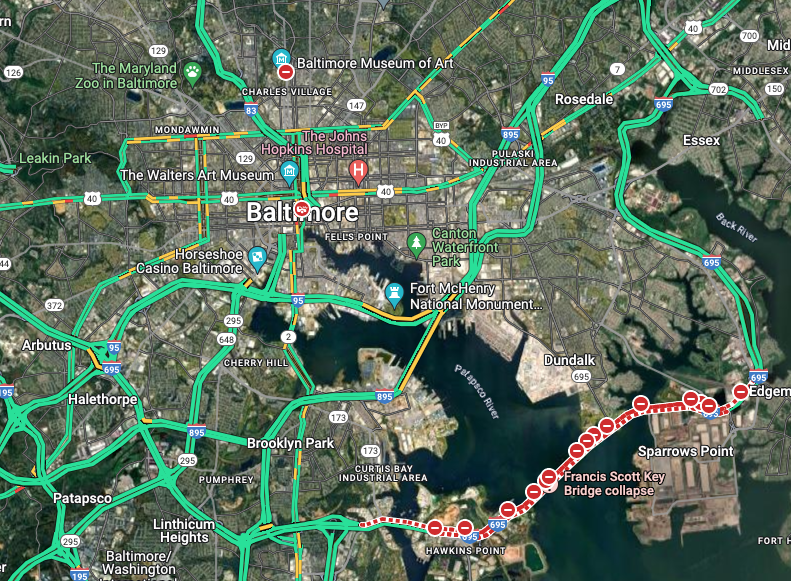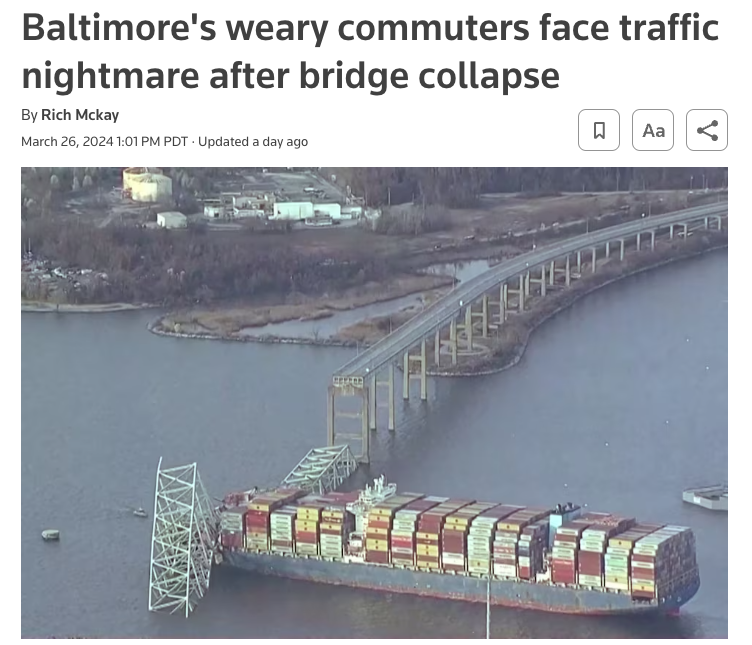On Tuesday, March 26, the containership Dali slammed into the Francis Scott Key Bridge in Baltimore, causing it to collapse into the Patapsco River. Tragically, six workers on the bridge were killed, but fortunately the collision occurred in the middle of the night, rather than during peak travel hours, when hundreds of vehicles would likely have been on the bridge. The Key Bridge is an important part of Baltimore’s freeway network, carrying about 35,000 vehicles per day. While President Biden has pledged to replace the bridge, that process could take years.
What would commuters and travelers do without this vital chunk of roadway? Surely, we’re headed for gridlock and carmageddon! Reuter’s warned its readers.
There was plainly some disruption on Tuesday’s morning commute, as people woke up to the disaster. But on Wednesday morning, despite some localized delays, pretty much nothing out of the ordinary happened. Here’s what Wednesday morning traffic looked like according to Google Maps

The Key Bridge and approaches (shown in red) are completely closed to traffic). The two highway tunnels under the harbor (carrying I-95 and I-895) have some slowing in one direction (NB on I-895, and SB on I-95). Despite these mostly local slowdowns, on most parts of the region’s highway network traffic seems to be moving with equal alacrity as on any typical weekday, despite the collapse of the Key Bridge and closure of several of its approaches. For comparison, here’s what a typical Wednesday morning looks like, according to Google’s historical data.

This isn’t an unusual occurrence. The same scenario is repeated, time and again, whenever a major section of roadway is removed from service, whether by construction, repair, or as a result of crashes. Just ask Philadelphia, Los Angeles, or Seattle, or Atlanta, or Minneapolis, or Portland. In every one of these cities, a key roadway was taken out of service for days, weeks or months. In every one of these cities, highway departments predicted calamitous delays and gridlock. And in every one of these cities, pretty much nothing happened. Traffic “just disappeared” and driving conditions “weren’t so horrible” and in several cases, congestion was less than usual.
The lesson here is that traffic is not an inalterable and irreducible quantity dictated by nature, its actually very dynamic and elastic. As David Zipper explains eloquently in Slate, travel patterns quickly adapt to changes in road capacity, especially in the case of dramatic events like a bridge collapse. People readily change their travel behavior in response to the availability of road capacity. That’s the essential insight behind the science of “induced demand“—the observation that newly expanded roadways quickly fill to capacity. And this is its mirror image: “traffic evaporation.”
Many of the trips on our roadway are discretionary. We can choose to take them at other times, take other routes, combine or forego trips, choose new destinations, or travel by other modes. The traffic we observe at any point in time is not a fixed and inexorable amount that must be “served” but is simply the behavioral response of humans to the set of transportation choices available to them.
The repeated failure of these predicted “carmageddons” to ever occur is powerful evidence that the key tenet of highway planning is fundamentally flawed. Highway departments claim that if we don’t build more roadways, traffic and congestion will increase without limit and we’ll face hours and hours of delay. In reality, that never happens because people adapt their travel behavior to the available transportation system. Widening roads in an effort to reduce congestion isn’t simply futile, it’s counterproductive. More capacity generates more travel, more sprawl, more pollution, and ultimately more congestion. It’s time to get off this treadmill.

